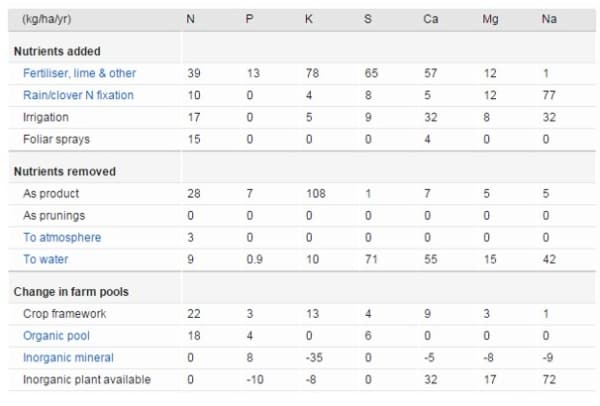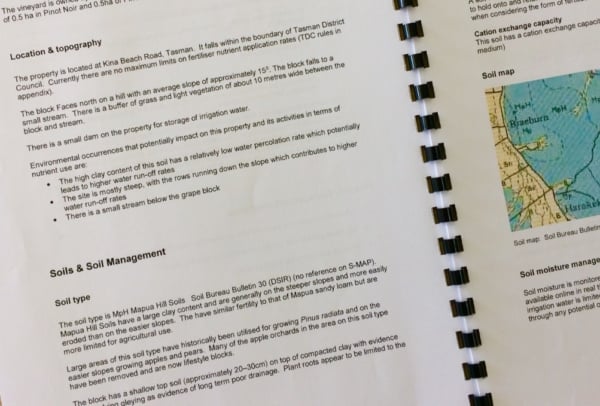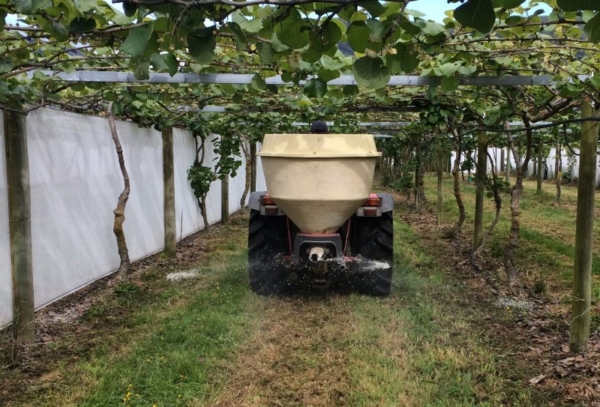What is involved in a Nutrient Management Plan and how can it help an orchard enterprise?
As first seen in the “Orchardist”.
Mike Nelson, Fruition Horticulture, Nelson & Ruth Underwood, Fruition Horticulture, Tauranga.
In this article, we’ll explain what a nutrient management plan entails and how an orchard can benefit from the process.
Nutrient management plans are required for farms in the dairying sector, mainly because of their greater use of nitrogen fertilisers and the influence of large animals that contribute to nitrogen leaching. While there is not the same requirement for an orchard operation to have a nutrient management plan, there are potential benefits in going through the process. These include identifying factors within the property that influence nutrient use and movement, maximising nutrient utilisation, minimising losses to the environment and meeting compliance requirements.
Aims of a Nutrient Management Plan are:
- Meeting production goals and quality requirements
- Specifying fertiliser inputs based on block-specific nutrient requirements
- Increasing plant nutrient utilisation efficiency and therefore return on fertiliser expenditure
- Reducing nutrient loss to the environment while maintaining or enhancing production
- Accounting for all nutrient inputs and outputs within the growing system
- Providing a clear record of on property nutrient awareness and best practice
Not all situations are the same. Different properties can have substantially different outcomes in the way nutrients are retained and utilised. Location, climate and soil type all have a big part to play in the way we need to manage nutrients.
Location of the orchard is important and council rules may have to be taken into consideration. Some sites are located near sensitive water catchments and require careful management, but small insignificant streams should also be considered for potential run-off as they inevitably flow into larger water ways. Topography and aspect are especially important with nutrients such as phosphate, which resists leaching but is prone to overland flow with rainfall on a sloped site. So the time of year when phosphate is applied can be important as well as form of product selected.
The total rainfall has a large influence on the amount of drainage through a soil type and consequently the amount of leaching occurring.
The soil type influences the water holding capacity and drainage characteristics of a block. Soils with lighter textures leach more nutrients and generally have a lesser ability to store nutrients and this is compounded by the amount of rainfall and drainage as above.
A Nutrient Budget can be generated for a specific block or total property using the software programme OVERSEER®®.. This software programme was developed by AgResearch to help farmers and growers to make informed strategic management decisions about their nutrient use, improve performance and reduce losses to the environment in New Zealand. Given a soil and climate type, and location OVERSEER®® models a seasonal nutrient usage by crop development stage, accounting for all nutrient inputs and losses. Fertiliser rates, products and application timing can be adjusted and the resulting impact on crop performance and environmental losses can be assessed.
OVERSEER® is mainly known in its’ use in pastoral and arable farming nutrient modelling. The fruit crops for which there are OVERSEER® models are apples, kiwifruit, grapes, avocados and peaches.
A nutrient budget accounts for the nutrient inputs and outputs in the system. Table 1 shows an apple orchard example. Nitrogen leaching levels are calculated, as well as phosphate loss, and while there has been some debate about the accuracy of the numbers generated for leaching in certain scenarios, it is a very useful tool to model, and compare, various nutrient strategies (nutrient types, rates and timing) to minimize losses into the environment while maintaining production. In other words (without getting too caught up in absolute numbers) is the nutrient management and choices leaching nitrogen in a low, medium or high rate? And, if we apply a management change what are the effects? Can we reduce the amount of leaching while maintaining production? OVERSEER®® is a very effective tool to assess this.
Table 1: Nutrient budget report from OVERSEER®® for an apple crop gross yield 70 T/ha

Timing fertiliser to periods of greatest crop demand reduces leaching losses, sometimes dramatically. In one example shifting the timing of nitrogen fertiliser, but not changing the quantity, reduced the leaching losses of nitrogen modelled in OVERSEER® by 2/3. Ideally nutrients are applied in periods of low drainage to reduce nutrient leaching from the soil. Rainfall in many growing regions is unpredictable, but periods of rapid plant growth and rapid nutrient uptake are known for each crop. Timing nutrients to these periods of greatest crop demand is good for production and for containing leaching losses.
It can also help to identify potential nutrient level trends (increasing or decreasing) over time. Many production factors are considered including production levels, soil type, location and rainfall. For example, some of the trends in re-running a kiwifruit orchard through OVERSEER® checking out different options showed:
- Potassium is the nutrient removed in the greatest quantity with the crop, taking over twice the amount of nitrogen removed. Third in line is phosphorus at about 1/8 the quantity of potassium removed. Still important are magnesium, calcium and sulphur although quantities removed with the crop are only about 60% of the amount of phosphorus removed, under 10% of the quantity of potassium. No wonder kiwifruit are a good source of dietary potassium!
- For young vines yielding at mature levels, the nutrients required by their expanding vine framework, such as leaders and thicker trunks, can be significant. For calcium, this required more than the amount removed in the fruit crop; for nitrogen required about 1/3 of the amount removed in the fruit, and about 15% of the amount of Potassium removed in the fruit, of course in addition to the quantities of nutrients removed with the harvested crop. This expansion of the vine framework needs to be supported with appropriate fertiliser nutrients.
- Adding a couple of foliar nitrogen applications added about the same amount of N as in rainfall or fixed from the atmosphere by clovers but did not increase leached nitrogen.
- Yield increased removal of nutrients with the crop, by about the same proportion as the change in crop volume i.e. 20% higher or lower yield means plus or minus 20% of the quantity of nutrients removed with the fruit.
Irrigation adds nutrients, so having details of a water sample can help indicate the impact of this, but otherwise a standard nutrient analysis can be used. Management of the irrigation system makes a difference too, due both to the nutrients added in irrigation water and to the effects on nutrients removed along with water draining through the soil.
Those are just changes modelled for one orchard. A different orchard will have different results due to the different soil type, climate and so on. For example, Table 1 shows the OVERSEER® nutrient budget for a 9 year old apple block in Nelson/Tasman yielding about 70 T/ha with a 75% pack out at 2900 TCE’s/ha. The figures show fertiliser potassium being applied is less than being removed with the crop, but some loss to water still occurs; nitrogen and calcium being added by rain/clover fixing and irrigation makes a significant contribution to amounts supplied, and nitrogen losses to water are relatively modest.
In summary, a nutrient management plan goes beyond a fertiliser recommendation to look at the wider nutrient picture for the orchard. OVERSEER® is a useful tool in the process and can be used for the main fruit crops grown in New Zealand.
Photo caption: A nutrient Management Plan includes comprehensive soil details.


Photo Caption: Management of the orchard sward affects nutrient budget; adding fertiliser when plant nutrient demands are highest reduces losses to the environment.
References:
Technical Description of OVERSEER®® for Regional Councils, N Watkins and D Selbie AgResearch, 2015.
The Fertiliser Association of New Zealand; Code of Practice, Nutrient Management Plan Template.
Ballance Agri-nutrients, Nutrient Management Plan Template.